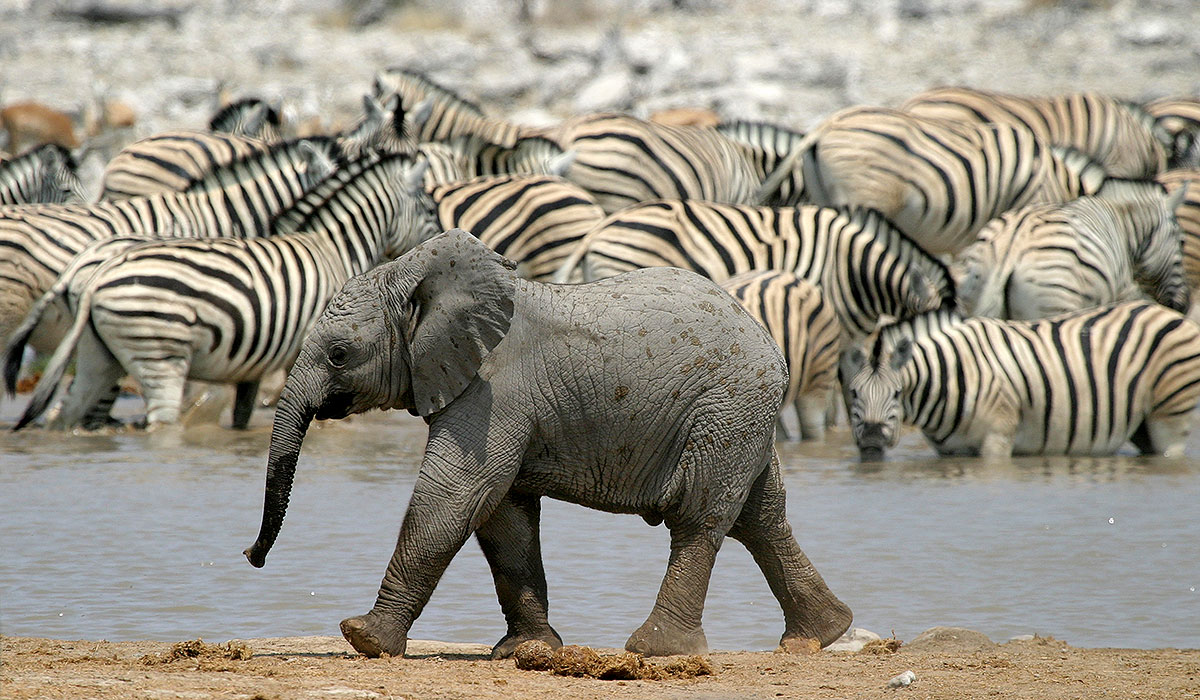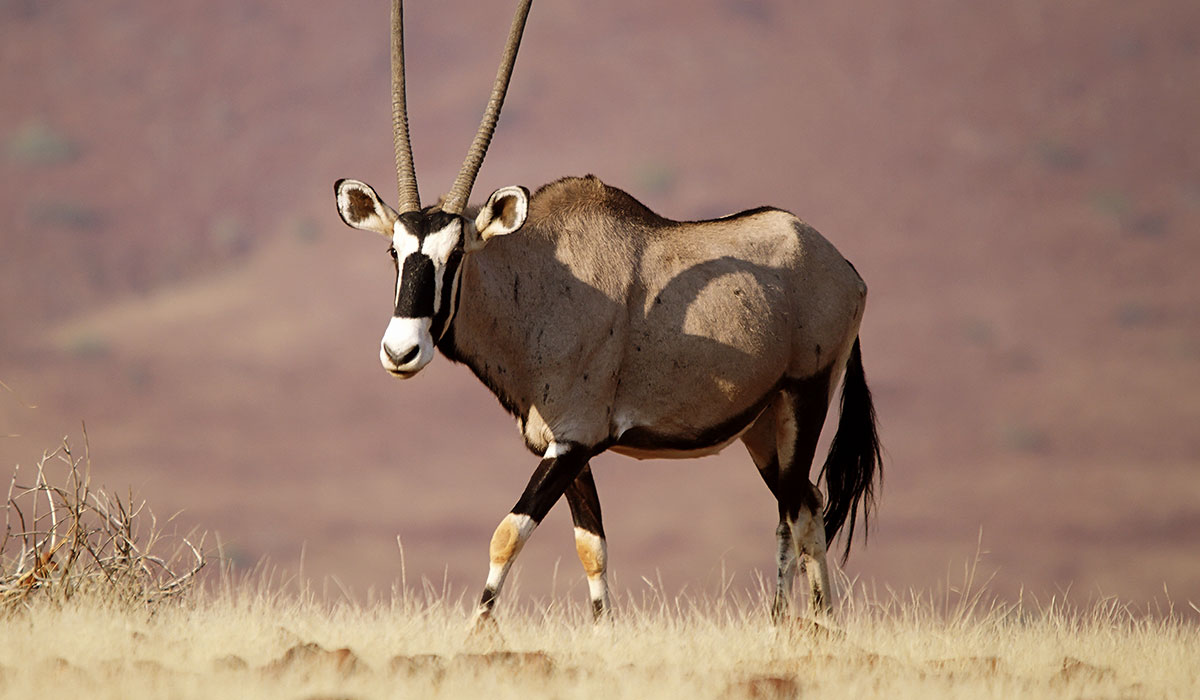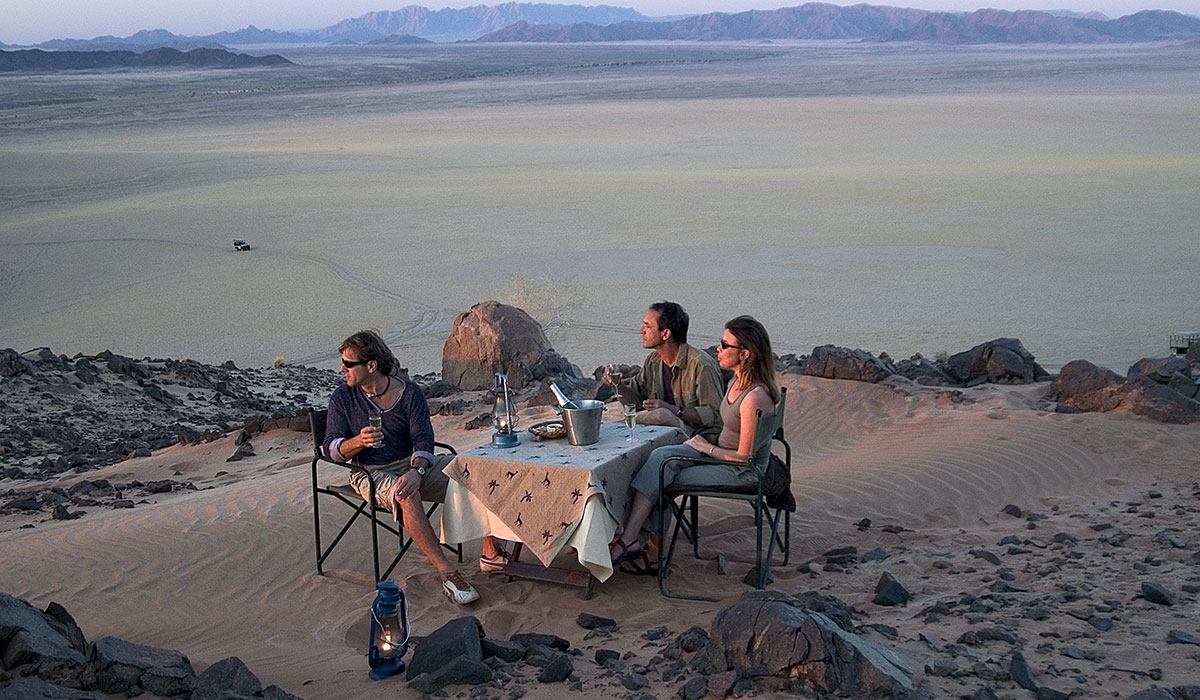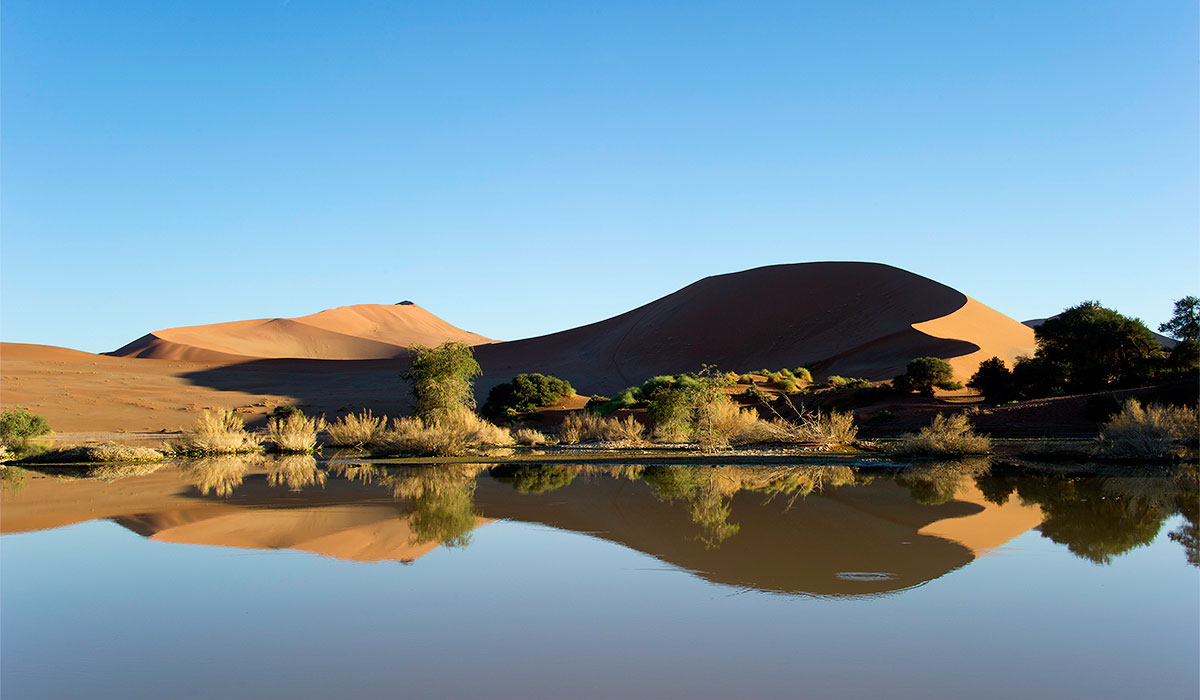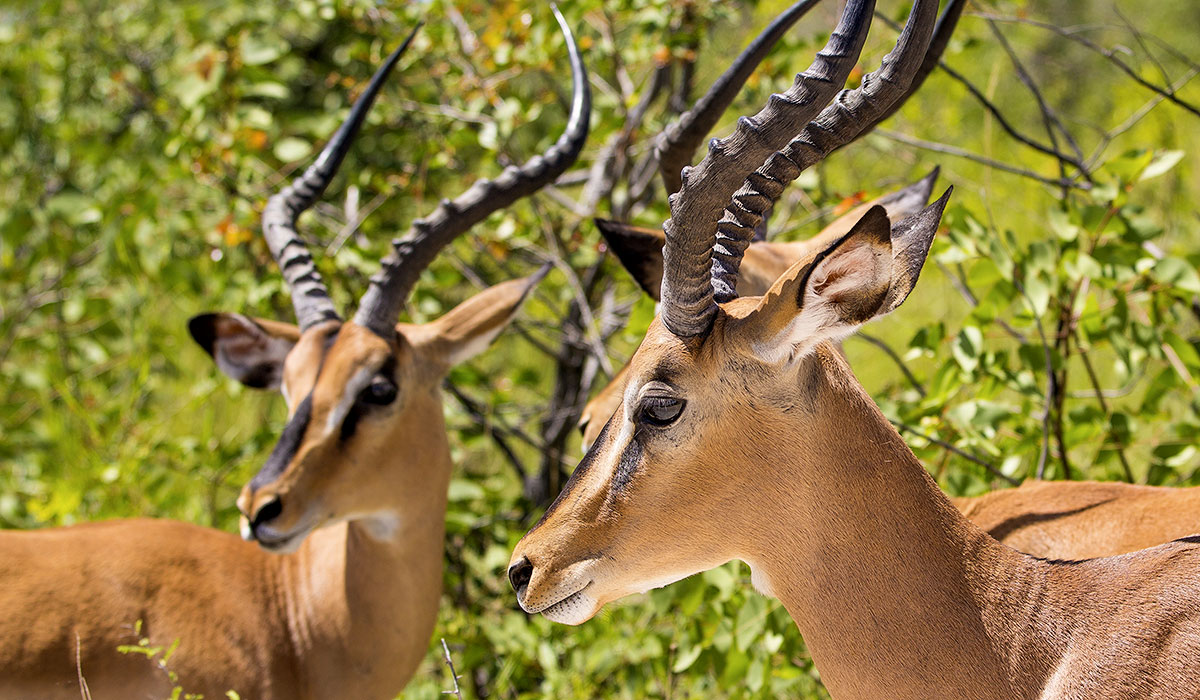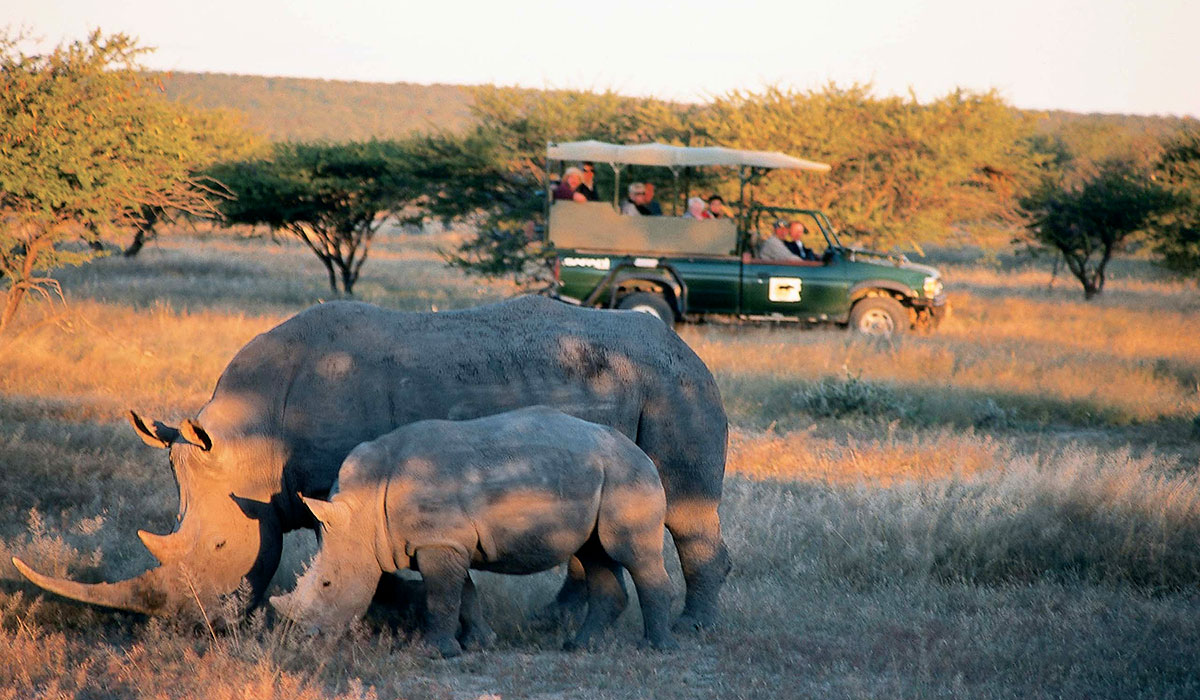Day 1 Arrive Windhoek
Welcome to Namibia! You will be met upon arrival and transferred to your hotel where the remainder of the day is at leisure. Get a good night's sleep tonight as a wonderful adventure begins in the morning.
Day 2 Windhoek-Sossusvlei (Namib Desert) | Meals: BLD
Depart from Windhoek by air and enjoy awe-inspiring views of the mountains and the desert floor. Arrive at Sossusvlei and the Namib - one of the most fascinating and scenically distinctive places on earth. The constantly shifting sand dunes of Sossusvlei are said to be the highest in the world - some over 1000 feet high. Spend two nights exploring the Sossusvlei region.
Little Kulala is a luxurious desert retreat situated in the private 37 000-hectare Kulala Wilderness Reserve – the gateway to Namibia's Sand Sea with its towering dunes and clear starry skies. Desert-adapted wildlife in the area is fascinating and is another dimension of this truly spectacular place.
Accommodation consists of 11 climate-controlled, thatched "kulalas" (the word means 'to sleep') which merge impeccably into the desert landscape, each with private plunge pool, both indoor and outdoor showers and a rooftop star bed for romantic star gazing. An elegant entertainment area includes a library, wine cellar, craft boutique, lounge and dining areas. Little Kulala’s interiors make use of neutral colours, gorgeous textures and natural light and takes its inspiration from its surroundings, notably from the magnificent Dead Vlei.
Highlights
×
Day 3 Namib Desert | Meals: BLD
Why not rise early this morning and enjoy an optional hot air ballon safari over the sand dunes? Then, choose from included activities such as a game drive that focuses on the desert game and desert-adapted flora and fauna. Look for plants like the welwitschia, said to live for 2,000 years - during which time it produces only two leaves!
Little Kulala is a luxurious desert retreat situated in the private 37 000-hectare Kulala Wilderness Reserve – the gateway to Namibia's Sand Sea with its towering dunes and clear starry skies. Desert-adapted wildlife in the area is fascinating and is another dimension of this truly spectacular place.
Accommodation consists of 11 climate-controlled, thatched "kulalas" (the word means 'to sleep') which merge impeccably into the desert landscape, each with private plunge pool, both indoor and outdoor showers and a rooftop star bed for romantic star gazing. An elegant entertainment area includes a library, wine cellar, craft boutique, lounge and dining areas. Little Kulala’s interiors make use of neutral colours, gorgeous textures and natural light and takes its inspiration from its surroundings, notably from the magnificent Dead Vlei.
Highlights
×
Day 4 Namib-Swakopmund & Damaraland | Meals: BLD
Leaving the sandy dunes, we make our way to the next destination with a scenic flight over the Namib Desert for a different perspective of the "dune sea", including the possibility of seeing shipwrech remains plus an old mining camp. After flying along a section of coastline to Swakopmund where we land for refueling, we head inland to the flat-topped mountains and fascinating riverbeds of northern Damaraland for two nights at Damaraland Camp.
Damaraland Camp is a rare venture which integrates communities, the environment and sustainable wildlife and is rated as the most successful ecotourism venture in Namibia. Located on the north bank of the Huab River Valley, 90 kilometres inland from Torra Bay on Namibia's Skeleton Coast, the camp presents endless vistas across stark plains, ancient valleys and soaring peaks. The brooding mass of the Brandberg provides a focal point, almost 100 kilometres to the south. Early morning mists, generated by the meeting of the icy Atlantic and the warm land mass along the Skeleton Coast, drift inland along the river line, providing sustenance to varied life forms. The river flows only once or twice during the short rainy season, seldom breaking through the dunes to the ocean.
Damaraland Camp was rated as one of the top destinations of the 'Ultimate Safari' in the March 1999 issue of Conde Nast Traveler.
Camp Description Nine large comfortable walk-in tents with doors. All tents have valley views and each has en suite facilities and a covered veranda. The main living area made from local rock and canvas combines the dining room, lounge and bar. A feature of the camp is a stunning rock plunge pool tucked away in a mini gorge behind the camp. Dinner can be enjoyed in an open air "kraal" under a million stars.
Game Viewing The natural laws of food and water availability dictate the movement and cycles of the rare and endangered desert Elephant, Black Rhinoceros, Oryx, Kudu, Springbok and other species that have come to terms with life in a desert environment. Even Lion and Cheetah move in and out of the area occasionally.
Activities Activities revolve around nature drives into the Huab River System in search of Desert Elephants and other specially adapted flora and fauna. Walking in the Damaraland area is spectacular and is highly recommended as an afternoon activity. With prior notice, a trip can be arranged to the famous Twyfelfontein rock engravings located nearby. A full day excursion is available to track the endangered Desert Adapted Black Rhino subject to the availability of a vehicle. Private vehicles for these excursions can be booked at an additional cost subject to availability either prior to departure or directly with the Camp Manager.
The Torra Conservancy Damaraland was voted in the top three of all eco-tourist projects around the world by the British Travel Writers guild. It is situated in the mountainous region in north~west Namibia inhabited by the Damaras and named after them. Originally, it was an area occupied primarily by the Damara people, but it soon became the home of other tribes such as the Hereros and the displaced Riemvasmakers of South Africa. Today, many residents of Damaraland are thus of mixed heritage, but most consider themselves Damara. The Damara name is derived from the Nama word "Dama", meaning "who walked here". This is because the Damara were known to the Nama people by the footprints they left around waterholes. From their vantage point in the mountains, the Damara were quick to spot resources such as water or animals, on the plains below, and they were therefore able to be the first groups to reach these essential resources. The Damaraland community comprises a unique group of people who have recognised the value of the wildlife on their land and formed a Community Wildlife Conservancy to protect it. Until 1981, Damaraland was unprotected and open to poachers, mostly from outside the area. Eventually, Namibian NGO's formed a game-guard system with people from the community, and interest in the welfare of the wildlife increased. After halting the poaching activities, there were many ideas on how to conserve the area and its resources sustainably. In 1996, Wilderness Safaris joined the community's conservation efforts and co-established what is now the most successful community based tourism venture in Namibia. In 1998, the success of Damaraland Camp helped the community to have their land proclaimed as the Torra Conservancy. It is now the leader of four Community Wildlife Conservancies in the country. Today, the Torra Conservancy is one of the most successful in all of Africa. It meets all its management costs and makes a profit which is then re-invested into community projects for their benefit. It is the first community conservancy which is able to sustain itself without donor funding.
×
Day 5 Damaraland | Meals: BLD
Damaraland Camp is famous for its diverse compliment of desert-adapted wildlife, especially elephant, and its highly successful partnership with the local Torra community. From your camp endless vistas unfold against stark plains and ancient valleys. Chances are good for encountering the endangered Desert Elephant - said to be able to go up to four days without water.
Damaraland Camp is a rare venture which integrates communities, the environment and sustainable wildlife and is rated as the most successful ecotourism venture in Namibia. Located on the north bank of the Huab River Valley, 90 kilometres inland from Torra Bay on Namibia's Skeleton Coast, the camp presents endless vistas across stark plains, ancient valleys and soaring peaks. The brooding mass of the Brandberg provides a focal point, almost 100 kilometres to the south. Early morning mists, generated by the meeting of the icy Atlantic and the warm land mass along the Skeleton Coast, drift inland along the river line, providing sustenance to varied life forms. The river flows only once or twice during the short rainy season, seldom breaking through the dunes to the ocean.
Damaraland Camp was rated as one of the top destinations of the 'Ultimate Safari' in the March 1999 issue of Conde Nast Traveler.
Camp Description Nine large comfortable walk-in tents with doors. All tents have valley views and each has en suite facilities and a covered veranda. The main living area made from local rock and canvas combines the dining room, lounge and bar. A feature of the camp is a stunning rock plunge pool tucked away in a mini gorge behind the camp. Dinner can be enjoyed in an open air "kraal" under a million stars.
Game Viewing The natural laws of food and water availability dictate the movement and cycles of the rare and endangered desert Elephant, Black Rhinoceros, Oryx, Kudu, Springbok and other species that have come to terms with life in a desert environment. Even Lion and Cheetah move in and out of the area occasionally.
Activities Activities revolve around nature drives into the Huab River System in search of Desert Elephants and other specially adapted flora and fauna. Walking in the Damaraland area is spectacular and is highly recommended as an afternoon activity. With prior notice, a trip can be arranged to the famous Twyfelfontein rock engravings located nearby. A full day excursion is available to track the endangered Desert Adapted Black Rhino subject to the availability of a vehicle. Private vehicles for these excursions can be booked at an additional cost subject to availability either prior to departure or directly with the Camp Manager.
The Torra Conservancy Damaraland was voted in the top three of all eco-tourist projects around the world by the British Travel Writers guild. It is situated in the mountainous region in north~west Namibia inhabited by the Damaras and named after them. Originally, it was an area occupied primarily by the Damara people, but it soon became the home of other tribes such as the Hereros and the displaced Riemvasmakers of South Africa. Today, many residents of Damaraland are thus of mixed heritage, but most consider themselves Damara. The Damara name is derived from the Nama word "Dama", meaning "who walked here". This is because the Damara were known to the Nama people by the footprints they left around waterholes. From their vantage point in the mountains, the Damara were quick to spot resources such as water or animals, on the plains below, and they were therefore able to be the first groups to reach these essential resources. The Damaraland community comprises a unique group of people who have recognised the value of the wildlife on their land and formed a Community Wildlife Conservancy to protect it. Until 1981, Damaraland was unprotected and open to poachers, mostly from outside the area. Eventually, Namibian NGO's formed a game-guard system with people from the community, and interest in the welfare of the wildlife increased. After halting the poaching activities, there were many ideas on how to conserve the area and its resources sustainably. In 1996, Wilderness Safaris joined the community's conservation efforts and co-established what is now the most successful community based tourism venture in Namibia. In 1998, the success of Damaraland Camp helped the community to have their land proclaimed as the Torra Conservancy. It is now the leader of four Community Wildlife Conservancies in the country. Today, the Torra Conservancy is one of the most successful in all of Africa. It meets all its management costs and makes a profit which is then re-invested into community projects for their benefit. It is the first community conservancy which is able to sustain itself without donor funding.
×
Day 6 Damaraland-Etosha National Park | Meals: BLD
A light aircraft flight takes you to Ongava Game Reserve and nearby Etosha National Park. Your flight reveals the considerable contrast of the stark and rocky scenery of Damaraland and the Kaokoveld and the richer woodland areas and grassy plains of wildlife-rich Ongava and Etosha. One of the largest parks in Africa, Etosha is perhaps most famous for the Etosha Pan - a shallow depression of over 1900 square miles. Later, enjoy a game drive in Etosha.
Ongava Lodge is cleverly constructed on the slopes of a small hill in the Ongava Game Reserve which lies on the southern boundary of Etosha National Park. From up here, guests can sit back and watch a host of wildlife species that come to drink at the waterhole just below – or sit quietly at the hide to see these close up.
13 chalets and one family room, attractively built out of brick, rock and thatch, have en-suite bathrooms, air-conditioning and glass-fronted doors leading onto a private veranda. There are impressive views of the waterhole and surrounding plains from the main lounge, bar and dining areas. Meals are either served under thatch or on the dining deck under the stars.
Highlights
×
Day 7 Etosha National Park | Meals: BLD
More game viewing in Etosha this morning. With some luck, you might spot the black rhino or the black-faced impala, both rare species. Bird watchers will delight in the almost 340 species found in Etosha.
Ongava Lodge is cleverly constructed on the slopes of a small hill in the Ongava Game Reserve which lies on the southern boundary of Etosha National Park. From up here, guests can sit back and watch a host of wildlife species that come to drink at the waterhole just below – or sit quietly at the hide to see these close up.
13 chalets and one family room, attractively built out of brick, rock and thatch, have en-suite bathrooms, air-conditioning and glass-fronted doors leading onto a private veranda. There are impressive views of the waterhole and surrounding plains from the main lounge, bar and dining areas. Meals are either served under thatch or on the dining deck under the stars.
Highlights
×
Day 8 Etosha-Windhoek | Meals: B
A light aircraft flight takes you back to Windhoek, where the remainder of the day is at leisure.
Day 9 Depart Windhoek | Meals: B
After a leisurely morning, you will be transferred to the airport to begin your journey home.
Welcome to Namibia! You will be met upon arrival and transferred to your hotel where the remainder of the day is at leisure. Get a good night's sleep tonight as a wonderful adventure begins in the morning.
Hotel Heinitzburg
Day 2 Windhoek-Sossusvlei (Namib Desert) | Meals: BLD
Depart from Windhoek by air and enjoy awe-inspiring views of the mountains and the desert floor. Arrive at Sossusvlei and the Namib - one of the most fascinating and scenically distinctive places on earth. The constantly shifting sand dunes of Sossusvlei are said to be the highest in the world - some over 1000 feet high. Spend two nights exploring the Sossusvlei region.

Little Kulala Camp
Little Kulala is a luxurious desert retreat situated in the private 37 000-hectare Kulala Wilderness Reserve – the gateway to Namibia's Sand Sea with its towering dunes and clear starry skies. Desert-adapted wildlife in the area is fascinating and is another dimension of this truly spectacular place.
Accommodation consists of 11 climate-controlled, thatched "kulalas" (the word means 'to sleep') which merge impeccably into the desert landscape, each with private plunge pool, both indoor and outdoor showers and a rooftop star bed for romantic star gazing. An elegant entertainment area includes a library, wine cellar, craft boutique, lounge and dining areas. Little Kulala’s interiors make use of neutral colours, gorgeous textures and natural light and takes its inspiration from its surroundings, notably from the magnificent Dead Vlei.
Highlights
- Little Kulala offers close proximity and private access to the dunes of Sossusvlei
- Explore the dramatic Kulala Wilderness Reserve on quad bike, hot air balloon, nature drive or on foot
- Dining under the sparkling clear Namibian skies is a speciality here
×
Day 3 Namib Desert | Meals: BLD
Why not rise early this morning and enjoy an optional hot air ballon safari over the sand dunes? Then, choose from included activities such as a game drive that focuses on the desert game and desert-adapted flora and fauna. Look for plants like the welwitschia, said to live for 2,000 years - during which time it produces only two leaves!

Little Kulala Camp
Little Kulala is a luxurious desert retreat situated in the private 37 000-hectare Kulala Wilderness Reserve – the gateway to Namibia's Sand Sea with its towering dunes and clear starry skies. Desert-adapted wildlife in the area is fascinating and is another dimension of this truly spectacular place.
Accommodation consists of 11 climate-controlled, thatched "kulalas" (the word means 'to sleep') which merge impeccably into the desert landscape, each with private plunge pool, both indoor and outdoor showers and a rooftop star bed for romantic star gazing. An elegant entertainment area includes a library, wine cellar, craft boutique, lounge and dining areas. Little Kulala’s interiors make use of neutral colours, gorgeous textures and natural light and takes its inspiration from its surroundings, notably from the magnificent Dead Vlei.
Highlights
- Little Kulala offers close proximity and private access to the dunes of Sossusvlei
- Explore the dramatic Kulala Wilderness Reserve on quad bike, hot air balloon, nature drive or on foot
- Dining under the sparkling clear Namibian skies is a speciality here
×
Day 4 Namib-Swakopmund & Damaraland | Meals: BLD
Leaving the sandy dunes, we make our way to the next destination with a scenic flight over the Namib Desert for a different perspective of the "dune sea", including the possibility of seeing shipwrech remains plus an old mining camp. After flying along a section of coastline to Swakopmund where we land for refueling, we head inland to the flat-topped mountains and fascinating riverbeds of northern Damaraland for two nights at Damaraland Camp.

Damaraland Camp
Damaraland Camp is a rare venture which integrates communities, the environment and sustainable wildlife and is rated as the most successful ecotourism venture in Namibia. Located on the north bank of the Huab River Valley, 90 kilometres inland from Torra Bay on Namibia's Skeleton Coast, the camp presents endless vistas across stark plains, ancient valleys and soaring peaks. The brooding mass of the Brandberg provides a focal point, almost 100 kilometres to the south. Early morning mists, generated by the meeting of the icy Atlantic and the warm land mass along the Skeleton Coast, drift inland along the river line, providing sustenance to varied life forms. The river flows only once or twice during the short rainy season, seldom breaking through the dunes to the ocean.
Damaraland Camp was rated as one of the top destinations of the 'Ultimate Safari' in the March 1999 issue of Conde Nast Traveler.
Camp Description Nine large comfortable walk-in tents with doors. All tents have valley views and each has en suite facilities and a covered veranda. The main living area made from local rock and canvas combines the dining room, lounge and bar. A feature of the camp is a stunning rock plunge pool tucked away in a mini gorge behind the camp. Dinner can be enjoyed in an open air "kraal" under a million stars.
Game Viewing The natural laws of food and water availability dictate the movement and cycles of the rare and endangered desert Elephant, Black Rhinoceros, Oryx, Kudu, Springbok and other species that have come to terms with life in a desert environment. Even Lion and Cheetah move in and out of the area occasionally.
Activities Activities revolve around nature drives into the Huab River System in search of Desert Elephants and other specially adapted flora and fauna. Walking in the Damaraland area is spectacular and is highly recommended as an afternoon activity. With prior notice, a trip can be arranged to the famous Twyfelfontein rock engravings located nearby. A full day excursion is available to track the endangered Desert Adapted Black Rhino subject to the availability of a vehicle. Private vehicles for these excursions can be booked at an additional cost subject to availability either prior to departure or directly with the Camp Manager.
The Torra Conservancy Damaraland was voted in the top three of all eco-tourist projects around the world by the British Travel Writers guild. It is situated in the mountainous region in north~west Namibia inhabited by the Damaras and named after them. Originally, it was an area occupied primarily by the Damara people, but it soon became the home of other tribes such as the Hereros and the displaced Riemvasmakers of South Africa. Today, many residents of Damaraland are thus of mixed heritage, but most consider themselves Damara. The Damara name is derived from the Nama word "Dama", meaning "who walked here". This is because the Damara were known to the Nama people by the footprints they left around waterholes. From their vantage point in the mountains, the Damara were quick to spot resources such as water or animals, on the plains below, and they were therefore able to be the first groups to reach these essential resources. The Damaraland community comprises a unique group of people who have recognised the value of the wildlife on their land and formed a Community Wildlife Conservancy to protect it. Until 1981, Damaraland was unprotected and open to poachers, mostly from outside the area. Eventually, Namibian NGO's formed a game-guard system with people from the community, and interest in the welfare of the wildlife increased. After halting the poaching activities, there were many ideas on how to conserve the area and its resources sustainably. In 1996, Wilderness Safaris joined the community's conservation efforts and co-established what is now the most successful community based tourism venture in Namibia. In 1998, the success of Damaraland Camp helped the community to have their land proclaimed as the Torra Conservancy. It is now the leader of four Community Wildlife Conservancies in the country. Today, the Torra Conservancy is one of the most successful in all of Africa. It meets all its management costs and makes a profit which is then re-invested into community projects for their benefit. It is the first community conservancy which is able to sustain itself without donor funding.
×
Day 5 Damaraland | Meals: BLD
Damaraland Camp is famous for its diverse compliment of desert-adapted wildlife, especially elephant, and its highly successful partnership with the local Torra community. From your camp endless vistas unfold against stark plains and ancient valleys. Chances are good for encountering the endangered Desert Elephant - said to be able to go up to four days without water.

Damaraland Camp
Damaraland Camp is a rare venture which integrates communities, the environment and sustainable wildlife and is rated as the most successful ecotourism venture in Namibia. Located on the north bank of the Huab River Valley, 90 kilometres inland from Torra Bay on Namibia's Skeleton Coast, the camp presents endless vistas across stark plains, ancient valleys and soaring peaks. The brooding mass of the Brandberg provides a focal point, almost 100 kilometres to the south. Early morning mists, generated by the meeting of the icy Atlantic and the warm land mass along the Skeleton Coast, drift inland along the river line, providing sustenance to varied life forms. The river flows only once or twice during the short rainy season, seldom breaking through the dunes to the ocean.
Damaraland Camp was rated as one of the top destinations of the 'Ultimate Safari' in the March 1999 issue of Conde Nast Traveler.
Camp Description Nine large comfortable walk-in tents with doors. All tents have valley views and each has en suite facilities and a covered veranda. The main living area made from local rock and canvas combines the dining room, lounge and bar. A feature of the camp is a stunning rock plunge pool tucked away in a mini gorge behind the camp. Dinner can be enjoyed in an open air "kraal" under a million stars.
Game Viewing The natural laws of food and water availability dictate the movement and cycles of the rare and endangered desert Elephant, Black Rhinoceros, Oryx, Kudu, Springbok and other species that have come to terms with life in a desert environment. Even Lion and Cheetah move in and out of the area occasionally.
Activities Activities revolve around nature drives into the Huab River System in search of Desert Elephants and other specially adapted flora and fauna. Walking in the Damaraland area is spectacular and is highly recommended as an afternoon activity. With prior notice, a trip can be arranged to the famous Twyfelfontein rock engravings located nearby. A full day excursion is available to track the endangered Desert Adapted Black Rhino subject to the availability of a vehicle. Private vehicles for these excursions can be booked at an additional cost subject to availability either prior to departure or directly with the Camp Manager.
The Torra Conservancy Damaraland was voted in the top three of all eco-tourist projects around the world by the British Travel Writers guild. It is situated in the mountainous region in north~west Namibia inhabited by the Damaras and named after them. Originally, it was an area occupied primarily by the Damara people, but it soon became the home of other tribes such as the Hereros and the displaced Riemvasmakers of South Africa. Today, many residents of Damaraland are thus of mixed heritage, but most consider themselves Damara. The Damara name is derived from the Nama word "Dama", meaning "who walked here". This is because the Damara were known to the Nama people by the footprints they left around waterholes. From their vantage point in the mountains, the Damara were quick to spot resources such as water or animals, on the plains below, and they were therefore able to be the first groups to reach these essential resources. The Damaraland community comprises a unique group of people who have recognised the value of the wildlife on their land and formed a Community Wildlife Conservancy to protect it. Until 1981, Damaraland was unprotected and open to poachers, mostly from outside the area. Eventually, Namibian NGO's formed a game-guard system with people from the community, and interest in the welfare of the wildlife increased. After halting the poaching activities, there were many ideas on how to conserve the area and its resources sustainably. In 1996, Wilderness Safaris joined the community's conservation efforts and co-established what is now the most successful community based tourism venture in Namibia. In 1998, the success of Damaraland Camp helped the community to have their land proclaimed as the Torra Conservancy. It is now the leader of four Community Wildlife Conservancies in the country. Today, the Torra Conservancy is one of the most successful in all of Africa. It meets all its management costs and makes a profit which is then re-invested into community projects for their benefit. It is the first community conservancy which is able to sustain itself without donor funding.
×
Day 6 Damaraland-Etosha National Park | Meals: BLD
A light aircraft flight takes you to Ongava Game Reserve and nearby Etosha National Park. Your flight reveals the considerable contrast of the stark and rocky scenery of Damaraland and the Kaokoveld and the richer woodland areas and grassy plains of wildlife-rich Ongava and Etosha. One of the largest parks in Africa, Etosha is perhaps most famous for the Etosha Pan - a shallow depression of over 1900 square miles. Later, enjoy a game drive in Etosha.

Ongava Lodge
Ongava Lodge is cleverly constructed on the slopes of a small hill in the Ongava Game Reserve which lies on the southern boundary of Etosha National Park. From up here, guests can sit back and watch a host of wildlife species that come to drink at the waterhole just below – or sit quietly at the hide to see these close up.
13 chalets and one family room, attractively built out of brick, rock and thatch, have en-suite bathrooms, air-conditioning and glass-fronted doors leading onto a private veranda. There are impressive views of the waterhole and surrounding plains from the main lounge, bar and dining areas. Meals are either served under thatch or on the dining deck under the stars.
Highlights
- Explore both the private Ongava Reserve and Etosha National Park
- The camp has impressive views of a waterhole and surrounding plains
- Enjoy a host of thirsty wildlife congregating around the waterhole in the dry season
×
Day 7 Etosha National Park | Meals: BLD
More game viewing in Etosha this morning. With some luck, you might spot the black rhino or the black-faced impala, both rare species. Bird watchers will delight in the almost 340 species found in Etosha.

Ongava Lodge
Ongava Lodge is cleverly constructed on the slopes of a small hill in the Ongava Game Reserve which lies on the southern boundary of Etosha National Park. From up here, guests can sit back and watch a host of wildlife species that come to drink at the waterhole just below – or sit quietly at the hide to see these close up.
13 chalets and one family room, attractively built out of brick, rock and thatch, have en-suite bathrooms, air-conditioning and glass-fronted doors leading onto a private veranda. There are impressive views of the waterhole and surrounding plains from the main lounge, bar and dining areas. Meals are either served under thatch or on the dining deck under the stars.
Highlights
- Explore both the private Ongava Reserve and Etosha National Park
- The camp has impressive views of a waterhole and surrounding plains
- Enjoy a host of thirsty wildlife congregating around the waterhole in the dry season
×
Day 8 Etosha-Windhoek | Meals: B
A light aircraft flight takes you back to Windhoek, where the remainder of the day is at leisure.
Hotel Heinitzburg
Day 9 Depart Windhoek | Meals: B
After a leisurely morning, you will be transferred to the airport to begin your journey home.


